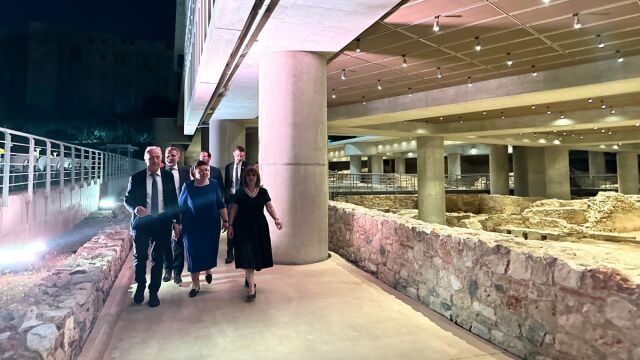In his spirit 15th anniversary of the operation on Acropolis Museum and its extremely successful journey, the official presentation to the Greek and international public of the new and particularly important museum space, which completes the Museum, took place in front of the President of the Republic. This is the “Museum under the Museum”, which offers visitors the greatly improved possibility of understanding and interpreting the remaining material and the history of an entire neighborhood of ancient Athens, discovered during systematic excavations, which was made in the area for the construction of the Museum and the “Acropolis” Station of the Athens Metro.
THE Minister of Culture Lina Mendoni expressed, in his greeting, his joy and pride for those who contributed decisively not only to the creation and reconstruction of the Acropolis Museum, but also as a Cultural Organization of international prestige and scope, which is counted, worldwide , among the leading and most numerous. popular in its kind, fully winning the recognition of experts and the praise of its hundreds of thousands of visitors every year.
Lina Mendoni: ”We are implementing an exemplary and model project of conservation, restoration and restoration of all the monuments of the Acropolis.”
Afterward, Lina Mendoni pointed out the details of their partnership Sculptors of the Parthenon: “On the construction, construction, and above all the operation of the Acropolis Museum”, he said, “Our country has destroyed the only – in the past – true and solid British argument, that Greece does not have suitable and worthy hosting infrastructures.. It is now widely accepted – almost universally, and internationally accepted – that Greece based its argument for the reunification of Glyptos, on tangible evidence of its strong will and its practical feasibility. and ability to protect them, preserve them, promote and manage them in both scientific and technical ways. For decades, we have implemented an ideal and model project of conservation, restoration and restoration of all the monuments of the Acropolis, including the Parthenon. 15 years later, it is very clear that the argument of the British Museum is not only invalid, but on the contrary, after the revelations of recent years, it is now completely reversed. In addition to the excellence of the infrastructure and the operation of the Acropolis Museum, its organic connection with the Rock and the monuments of the Acropolis, its symbiotic relationship with the modern and the ancient, the superstructure and the substructure, and the urban landscape with the historical which is present and past in Athens, they make it ideal to welcome and host the entire Parthenon Sculptures as one and indivisible unit. This Museum contains the best physical and conceptual framework for promoting, interpreting and understanding his masterpieces”.
The excavation site, in the architectural proposal of Bernard Tsoumi and Michalis Fotiadis, is considered an extension of the Museum’s exhibition, as physical and conceptual continuity and navel, connecting the new building with space and time. Five years ago, the excavation became accessible to visitors, who had the possibility, in addition to a guided tour of the Museum’s rooms, to browse the underlying antiquities.
“At this point,” said Lina Mendoni, “I have a moral duty to remember personally and publicly the struggle of Dimitris Pandermalis for the establishment of the Museum, for the excellent arrangement of the excavation findings, for the defense of the general project, against all forms and colors of populism, which did not hesitate to carry out the excavation. The construction and exemplary operation of this Museum, the current exhibition of movable finds in the excavation area, the overall project as a whole, is the mouth-watering response of all of these, the so-called lovers of monument, but in fact of the vulgar populism, which now goes through the same way in the same cases. Of the 5.5 hectare excavated area, 5.4 sq.m. to build the museum building. Dimitris Pandermalis and I – as Secretary General of the Ministry of Foreign Affairs and President of KAS – crossed the threshold of the investigator 109 times”.
The neighborhood, below the Museum, built at the top of the slopes of the southern slope of the Acropolis stone, hosted, almost without interruption, the life and activities of the city’s inhabitants from the 4th millennium BC to 12th century. AD Streets, houses, baths, workshops, shops, cemeteries coincide or succeed each other over time in a wider area. About this place, Thucydides – in his second book – referring to the history of Athens, says that it is one of the oldest in the city and with some of its oldest and most sacred sanctuaries. Until it was abandoned and abandoned, at a time when Athens as a whole was declining and declining.
“Here, in this space”, pointed out the Minister, “a complex and extremely interesting, historically and archaeologically, palimpsest of tools and buildings created, representative of the life of the poor popular class, but also of the social and intellectual elite in successive stages. Today, the permanent exhibition of more than 1100 mobile finds from the excavations, the “Museum under the Museum”, completes the image of the ancient neighborhood. Located in the southern part of the archaeological site, it is in line with the visitors’ route, which contributes to a better understanding of the daily life of the people who lived here for more than 4,500 years.”
Finally, Lina Mendoni thanked the General Director Nikos Stampolidis and the staff of the Museum, “because the Museum is not its shell and infrastructure but primarily its people, who built and created it, first of all the late friend that Dimitris Pandermal. The exhibition inaugurated is a tribute to his memory.” He also thanked the Governor of the Bank of Greece, Giannis Stournaras, for his generous sponsorship, which financed the “Museum under the Museum”.

